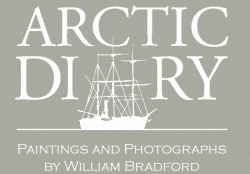
FEBRUARY 17–may 5, 2002
paintings & photographs
The Arctic was a source of great interest during the nineteenth century. As explorers strove for the Pole, a fascination blossomed in the public imagination, which was manifest in a widespread desire for images, factual and fantastical, and stories of the region. Bradford, a seasoned artist-explorer, was able to provide both. On the strength of the perceived veracity of his paintings and photographs--The Art Journal declared Bradford's to be "the only works which profess incontrovertible truth in the representation of the northern regions"-- he helped to satisfy the public's passion for all things Arctic.
Photography played an important role in Bradford's painting process. In addition to his sketches, he used photographs as inspiration for his paintings. In fact, some of his paintings can be matched with almost identical photographs, such as Steamer "Panther" among the Icebergs in Melville Bay (1874) and "The Farthest point reached . . ." from The Arctic Regions. However, Bradford infused his paintings with color, drama, and narrative not evident in the black-and-white albumen prints.
Based on photographs but bolstered by memory and imagination, Bradford's paintings depict an Arctic simultaneously alluring and dangerous. The "Panther" in Melville Bay (1873), for example, portrays the region as beautiful but barren, both a paradise and a wilderness. It is fitting that this very painting, an exemplary image of the Arctic as it existed in the Victorian imagination, was commissioned by Queen Victoria herself. Indeed, many of Bradford's paintings deal more in metaphor than reality. Ice Dwellers Watching the Invaders (c. 1875), for example, is based on a specific episode described in The Arctic Regions but also illustrates the elemental struggle between man and nature and the risk involved in the eternal quest for the unknown. Bradford's large-scale paintings reveal themselves not as "incontrovertible truth," but, more accurately, as symbolic portraits of a mythical and romantic Arctic that had captured the Victorian imagination.

Plate 98
 Steamer "Panther" among the Icebergs in Melville Bay
Steamer "Panther" among the Icebergs in Melville Bay

Plate 103

The "Panther" in Melville Bay

Ice Dwellers Watching the Invaders
